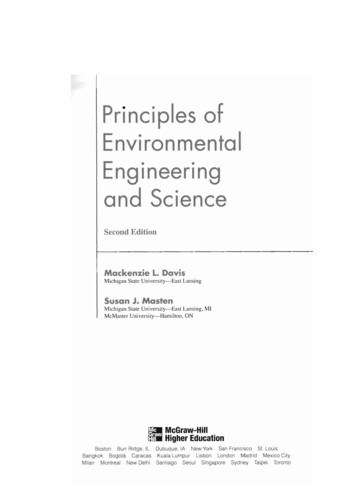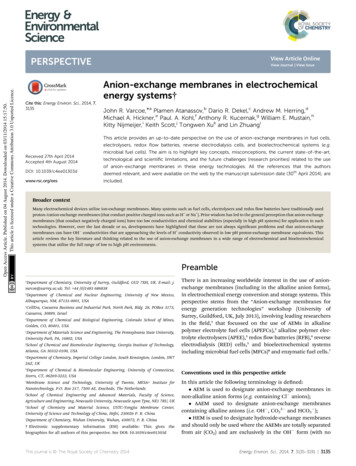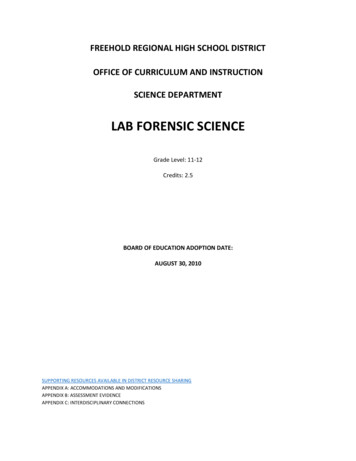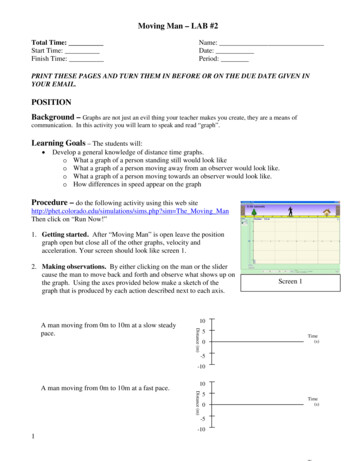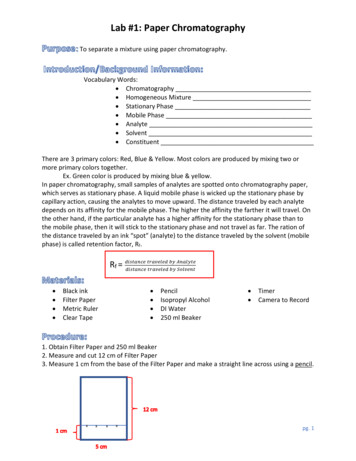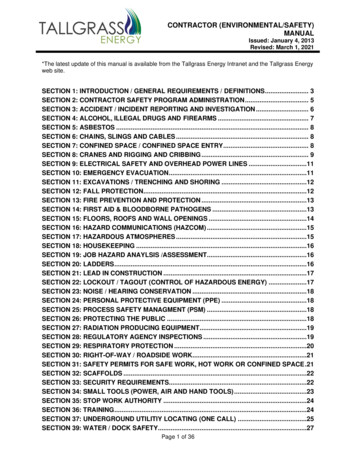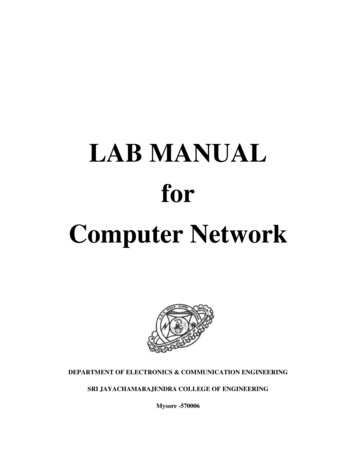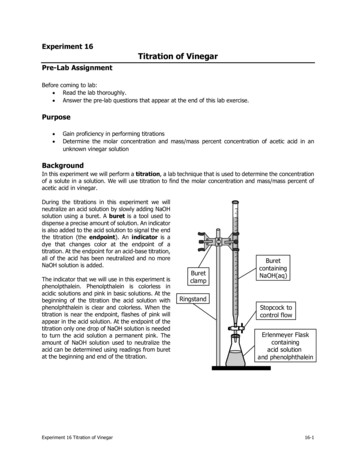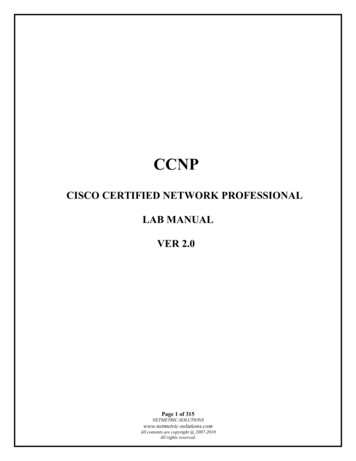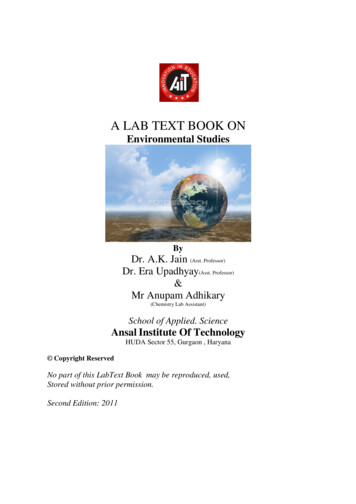
Transcription
A LAB TEXT BOOK ONEnvironmental StudiesByDr. A.K. Jain (Asst. Professor)Dr. Era Upadhyay(Asst. Professor)&Mr Anupam Adhikary(Chemistry Lab Assistant)School of Applied. ScienceAnsal Institute Of TechnologyHUDA Sector 55, Gurgaon , Haryana Copyright ReservedNo part of this LabText Book may be reproduced, used,Stored without prior permission.Second Edition: 2011
PREFACEEnvironmental studies is multidisciplinary branch consists of chemical sciences,physical sciences, biological sciences and various engineering branches. So, it is veryimportant that students of Environmental Science perform lab experiments to fullyunderstand that the theories they study in lecture and in their textbook are developed fromthe critical evaluation of experimental data. The laboratory can also help the student todevelop interest in the study of the Environmental Science by clearly illustrating theprinciples and concepts involved. Finally, laboratory experimentation teaches studentsthe opportunity to develop techniques and other manipulative skills that students ofEnvironmental Science must master for application in career and daily life.The faculty of the Environmental Science/Chemistry at AIT clearly understands theimportance of laboratory work in the study of Environmental Science and committed toeducate the student in lab skill and hopes that they will take full advantage of thisopportunity. This Environmental Science lab manual provides the students clear,comprehensive and upto date information about the various practical of EnvironmentalScience.This Environmental Science lab manual is designed to meet the need of GGSIPUniversity B.Tech 2nd semester studentsIn addition, students are encouraged to complete the report as soon after laboratory aspossible, as this is much more efficient than waiting until the nightBefore it is due. In conclusion, we view this manual as one of continual modification andimprovement. We encourage you to discuss ideas for improvements or suggestions withauthor. Finally, we hope you find this laboratory manual helpful in your study ofchemistry.Dr. A.K.JainDr. Era Upadhyay & Mr Anupam AdhikaryAcknowledgementFor Internal Circulation only2Dr. A.K.Jain, Dr. Era Upadhyay & Mr Anupam Adhikary
First we bow down at the feet of “Almighty God” and pray for peace in world and letnoble thoughts come to me from the universe and by the eternal blessing ofomniscient almighty as to enable persist always in me the strong belief of devotionand determination that anything incomprehensible on the holy earth iscomprehensible through team work with the pleasure each moment, we spent workingon this lab manual.It gives us deep pleasure to express our sincere gratitude to Prof. M.P.SinghDirector Ansal Institute of Technology, Gurgaon for his valuable guidance forpreparing this manual.We would like to pay our sincere gratitude to Prof. H.S Sexana, Dy. DirectorAnsal Institute of Technology, Gurgaon for providing us all the facility and supportfor this work. We are also highly thankful to Dr. Atul Kumar, Head Applied Scienceand Humanities for his valuable suggestions.Last, But not least we wish to thank all those, whose names have not figuredalone but have helped us directly and indirectly during the course of this work.Dr. A.K.Jain,Dr. Era Upadhyay & Mr Anupam AdhikaryFor Internal Circulation only3Dr. A.K.Jain, Dr. Era Upadhyay & Mr Anupam Adhikary
Subject code ETCH-154Subject title - Environmental Studies LabP2C1LIST OF EXPERIEMNTS1.Determination of Alkalinity in the water sample2.Determination of dissolved oxygen (DO) in the water sample.3.Determination of Biological Oxygen Demand (BOD) in the water sample.4.Determination of chemical oxygen demand (COD) in the water sample.5.Determination of pH, Conductivity and turbidity in some drinking water sampleand preparation of report.6.Determination of residual chlorine in the water sample.7.Determination of pH and conductivity of soil/ sludge samples.8.Determination of moisture content of soil sample.9.Determination of Total dissolved solids in water / effluent sample.10.Preparation of Urea-Formaldehyde polymer.11.To determine a) λ max of the solution of KMnO4 b) Verify Beer’s law and findout the concentration of unknown solution by spectrophotometer.12.To determine the concentration of iron in water sample13.To determine the concentration of particulate matter in the ambient air using Highvolume Sampler.For Internal Circulation only4Dr. A.K.Jain, Dr. Era Upadhyay & Mr Anupam Adhikary
Table of contentPreface2.Acknowledgement3.List of experiment4.General rules for the safe working of students in the laboratory.6.EXP No. 1.Determination of Alkalinity in the water sample10.EXP No. 2.Determination of dissolved oxygen (DO) in the water sample.14.EXP No.3.Determination of Biological Oxygen Demand in the water sample.18.EXP No. 4. Determination of chemical oxygen demand in the water sample.22.EXP No.5. Determination of pH, Conductivity and turbidity in some drinking watersample and preparation of report.26EXP No. 6. Determination of residual chlorine in the water sample.29.EXP No. 7. Determination of pH and conductivity of soil/ sludge samples.32.EXP No. 8. Determination of moisture content of soil sample.34.EXP No. 9. Determination of Total dissolved solids in water / effluent sample.37.EXP No. 10. Preparation of Urea-Formaldehyde polymer.39.EXP No. 11.To determine a) λ max of the solution of KMnO4 b) Verify Beer’s law andfind out the concentration of unknown solution by spectrophotometer.42EXPNo.12 To determine the concentration of iron in water sample by spectrophotometricmethod.For Internal Circulation only465Dr. A.K.Jain, Dr. Era Upadhyay & Mr Anupam Adhikary
GENERAL RULES FOR THE SAFE WORKING OF STUDENTS IN THELABORATORY.Laboratory Safety1. State-approved safety goggles must be worn in the laboratory at all times.This is required by state health regulation. Failure to observe this requirement willresult in your removal from the laboratory. The cost is approximately Rs100 (andtrivial in comparison to your eyesight). Safety glasses, etc. are not acceptable. Ifyou already have goggles, you will not be allowed in the laboratory and,consequently, will miss the experiment.2. The use of contact lenses in the laboratory is absolutely prohibited. In the caseof a splash or other emergency, they may interfere with the flushing of the eye,you may not be in a position to remove them, and those administering first aidmay not know that you are wearing them or might not be able to remove themeasily.3. You must dress appropriately for the laboratory. Lab coats are required to beworn. Bare feet, sandals, or other open-toed shoes are not permitted in thelaboratory. Shorts and short skirts are likewise not permitted; legs must becovered to below the knees. Headphones are not allowed in the laboratory.Failure to observe these requirements will result in your removal from thelaboratory. Cotton clothing (including denim) is particularly susceptible to beingeaten by acid solution. The laboratory is not a good place to wear your favoriteclothes. Long hair should be tied back.4. Learn the location and operation of the safety showers, emergency eyewashes andfire extinguishers in the laboratory. In the case of spill onto a person or clothing,the immediate action should be to flush with water and lots of it. Do not hesitateto yell for help. Report accidents to your instructor. He/she has been certified toFor Internal Circulation only6Dr. A.K.Jain, Dr. Era Upadhyay & Mr Anupam Adhikary
administer first aid. If you are not familiar with the operation of the fireextinguishers, ask your instructor to explain them to you.5. The fire extinguishers should only be used for real emergencies since thechemicals they contain can cause considerable damage. In any emergency thatrequires the assistance of the fire department, aid car, or police, sends someone tothe stockroom for assistance. Should clothing catch on fire, remain as calm aspossible. Walk (do not run) to the safety shower and pull the ring to douseyourself with water. Alternatively, you may drop to the floor and roll toextinguish the flames.6. Become familiar with all of the exits from the laboratory. A repeating siren andflashing of the FIRE indicator is the building evacuation signal. If this alarm goesoff while you are in the lab, turn off any open flames, grab your valuables, andleave the building as quickly as possible.7. Never attempt any unauthorized or unassigned experiments. Follow theexperimental procedures explicitly, checking and double-checking the identity ofall reagents before you use them. There are potentially hazardous combinations ofchemicals present in the laboratory. If you have an idea for further investigation,discuss it with your instructor.8. Clean up spills immediately. The next person to come along has no way ofknowing if the clear liquid or white powder on the lab bench is innocuous orhazardous. Neutralize acid spills with sodium bicarbonate (baking soda) beforecleaning them up. Spills of sulfuric acid solutions are particularly hazardous sinceonly the water will evaporate, thereby making the solution more concentratedupon standing.9. Never return unused reagents to their storage container. If you take more thanyou need, dispose of the excess in the appropriate manner. Use the reagentssparingly—they are expensive and time-consuming to prepare. When takingreagents, transfer the amount you need to a clean beaker or other suitablecontainer for taking the material back to your desk. Never insert a pipette or anyFor Internal Circulation only7Dr. A.K.Jain, Dr. Era Upadhyay & Mr Anupam Adhikary
other object into a liquid reagent container. Finally, check and double-check theidentity of all materials before using them.10. Do not pick up hot objects. Be sure your apparatus is cool before picking it up.Do not point the open end of a test tube or other vessel containing a reactionmixture toward yourself or anyone else. If the procedure calls for you to observethe odor of the contents of a vessel, hold it upright in front of you, gently fansome of the vapors toward your nose and sniff cautiously. Most chemical vaporsare at least irritating, and many are quite toxic. Please do not taste any chemicals.11. Do not eat, drink or smoke in the laboratory.12. Playing of radios, tapes, CDs is not permitted. This includes small portabledevices used with earphones or headsets.13. Keep coats, backpacks and other non-essential materials away from areas wherepeople are working.14. Dispose of all broken glassware and other sharp objects in the cardboard glassdisposal boxes. Custodial personnel will stop collecting trash after they findbroken glass in the trashcans.15. Wash hands often when working in lab, and always wash thoroughly beforeleaving.16. Use the hood for evaporation of anything other than water. The vapors from yourprocedure alone may not present a problem but those from all the students in thelab could combine to create a hazard.17. Do not leave a Bunsen burner or other heated apparatus unattended. Theperson working next to you may not know what is involved with your setup andmay be working with a flammable material. Turn off open flames if you mustleave your area. Make sure the gas taps are completely off whenever the Bunsenburner is not lit.18. Waste Disposal Dispose of chemical reagents and other materials properly. Theproper disposal of chemical wastes is essential to the health and safety of Institutefaculty, staff, students and the surrounding community.For Internal Circulation only8Dr. A.K.Jain, Dr. Era Upadhyay & Mr Anupam Adhikary
19. Chemical wastes must be managed and discarded in the most responsible andenvironmentally sound method available.Miscellaneous Policies and ProceduresHomework and Lab Report Due Dates. Lab reports are due one week from the dateof performance, at the beginning of the lab period. Only a verifiable illness (Doctor’snote) or prior permission of the instructor counts as excused absences. Unexcused labreports will receive a grade of zero.Lab Partners. For those experiments where students are to work in pairs, labpartners will be assigned randomly as announced by the instructor at the beginning ofthe lab period. You may not exchange lab partners. Both lab partners must be presentfor the entire experiment.Copying. All lab reports are to be your own. Lab partners are to independentlyproduce their lab reports. It is very easy for the grader to spot identical work amongtwo or more students. In the event of copying, all students involved will receive agrade of zero; therefore do not give a copy of your lab report to another student.Make-Up Labs. There will be no make-up labs.For Internal Circulation only9Dr. A.K.Jain, Dr. Era Upadhyay & Mr Anupam Adhikary
Experiment No 1 Date .Objective: To Determine the Alkalinity of a given Water Sample.Apparatus Required: Burette, Pipette, Conical Flask, and Beakers.Chemicals Required: N/10 HCl, Phenolphthalein and Methyl Orange.Theory:Alkalinity in water is due to the presence of different ions in water. Determination of alkalinity inwater is based on titration of water sample against a standard acid using selective indicators. Theindicators used are phenolphthalein and methyl orange. The following reactions take place –i) OH- H H2Oii) CO3 2- H HCO3iii) HCO3- H H2CO3The volume of the acid used up to phenolphthalein end point corresponds to the reaction i) andii), i.e., complete neutralization of OH- ions and CO3 2- ions up to HCO3- stage. The volume of theacid used up to methyl orange end point corresponds to the reaction i), ii), iii), i.e., completeneutralization of OH-, CO3 2- and HCO3- ions.Thus from the volume of respective titration the strengths of various ions can be determined. Bymeasuring phenolphthalein alkalinity and methyl orange alkalinity, it is possible to calculate themagnitude of various forms of alkalinity present in water samp
The laboratory can also help the student to develop interest in the study of the Environmental Science by clearly illustrating the principles and concepts involved. Finally, laboratory experimentation teaches students the opportunity to develop techniques and other manipulative skills that students of Environmental Science must master for application in career and daily life. The faculty of .



